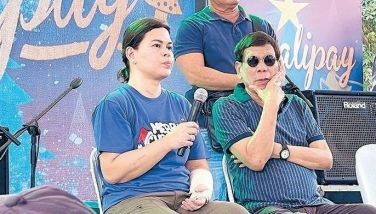Cincinnatus and GMA’s million jobs program
January 11, 2002 | 12:00am
(Conclusion) |
Let me outline the strategic framework we use in the Million Jobs Program to give people a clearer idea of how we move forward and to see which steps they can adopt or be a part of, much like the "model winners" we have begun to see in various commodity sectors:
1. Identify the market. Today‘s order is global competitiveness, and this dictates a market-driven supply chain. Before you even think about what to plant, make sure there’s a market that will buy whatever you produce. It could be domestic, meaning products and raw materials that increase the local content of manufactured food products, e.g. the local content of manufactured coffee and ingredients like corn and cassava. Our country is a net importer of food, spending millions every year on imported rice, corn, cassava, and coffee, among others; we’re now developing model farms that can grow these commodities and make us self-sufficient. Thanks to companies like Nestle, San Miguel, and others, markets are assured. Beyond the domestic market, we’re also looking at export performance and potentials of export winners like banana, mango, and coco chips for the international health snack market; and off-season perishable produce like leafy vegetables, asparagus, highland banana, ginger, and squash (kalabasa).
2. Designate the enterprise movers. To mobilize the components of the project, we have champions like agri entrepreneurs with products and services that serve a market niche, LGUs that have allocated land or financial resources to enter into market ventures with the private sector, and legislators with agri development programs in their districts.
We’ve met quite a number of these champions, each one’s story a source of hope for other aspirants. Henry Lim of SL Agritech, a Filipino-Chinese entrepreneur who was able to bring to our soil the high-yielding hybrid seeds developed by Professor Yuan Longping in China, crossed them with another variety produced by our IRRI and PhilRice, and reaped unprecedented yields of 7.9 MT/ha in Laguna and 8.8 MT/ha in Davao (our average yield for rice is just about 3.6 MT/ha). Today we use 2.5 million hectares of land for rice production; with high-yielding hybrid rice, we need actually use only 1.5 million hectares and make additional land available for other crops that have higher value and use less water. We also need not resort to importation, as we do every year. This is why we’re pushing for hybrid rice production on top of the Department of Agriculture’s hybrid and certified seed program. Besides Henry, we have many other movers like seed-growers and cooperatives in Nueva Ecija, rice farmers and cooperatives in San Manuel and Roxas under Isabela Gov. Jun Dy, in Banaybanay, Davao Oriental with Gov. Palma Gil, and in Davao del Norte with Gov. Dolfo del Rosario.
3. Locate suitable production areas. Precision farming is critical. We develop the farm plan after having established climatic and agronomic requirements, with details on soil, fertilizers, irrigation, mechanization, crop protection, harvesting, and post-harvest. We also consider the impact on the environment.
Across the country, we have many farms of various sizes that are underutilized for one reason or another. Be creative. As the marketing gurus like to put it, "think out of the box." Take a fresh approach to an old problem. In Jolo, for example, the Loong family owns a coconut farm which unfortunately was bearing the brunt of depressed coconut prices. But that land could be planted to coffee intercropped under the coconut trees. So we had Mayor Magdar Loong and his brother Ben meet with Land Bank. The municipality of Parang used their IRA (internal revenue allotment) as collateral for a Land Bank loan of P38 million, which was then released to five cooperatives undertaking the coffee project. They started with 180 hectares, and as their peers in the neighboring farms see their success, this area can expand to 1,000 hectares. Our ultimate target is 5,000 hectares. Also, it’s a project that goes all the way to the market — Nestle Philippines has committed to buy the coffee; again, instead of importing, we’re able to supply this need domestically and benefit our own farmers.
4. Benchmark competitive attributes. The project must meet best standards "from seed to shelf," or at each stage from production all the way to delivery to the market. It must also be competitive in cost, quality, reliability of supply, and customer service.
We have several agricultural products that can be considered globally competitive. Our Guimaras mangoes are regarded as the best in the world. In Bukidnon, we’re developing highlight bananas and special pineapple varieties for export. Tadeco is also working on this in upper Calinan.
5. Determine the jobs created. We count the labor requirement per unit area for raising crops, per unit number of head of livestock, or per type of fishing vessel or method of catching deep-sea fishes. For example, given the target of 135,000 hectares in hybrid rice production of 2002, we expect to employ 16,038 in seed production and another 55,500 in rice cultivation, for a total of 71,538 jobs this year. As we expand production to 200,000 hectares in 2003 and to 300,000 hectares in 2004, we’ll be able to create jobs in the rice sector for an estimated 334,880 in all.
6. Pinpoint implementation bottlenecks. Reviewing the project’s total chain, we identify specific gaps or obstacles, be they in credit access, technical knowhow, or logistics. One stumbling block that agri entrepreneurs commonly encounter is access to credit, which, where agriculture is concerned, is almost always expensive, tedious, or time-consuming. Financing is critical for working capital and inputs, so we need to improve this area by streamlining the bureaucracy. We do know that the Land Bank can give better rates and fasttrack processing when the cooperative is current with the Cooperative Development Agency.
7. Channel government assistance where necessary. Where getting the project operational requires help from government, such as through DA, DAR, DENR, DTI, their agencies, and financial institutions, we facilitate solutions-oriented dialogues and make sure issues are acted on within a specified timeframe. On the other hand, for projects that need to be "rescued," we also facilitate credit restructuring discussions especially with GFIs like Land Bank, since many borrowers very clearly need to revisit their credit commitments. Let’s realize that it is in the interest of both creditor and borrower to formulate a sound credit package and to jointly make sure the business succeeds.
The challenge of the Million Jobs Program is no walk in the park! It takes a lot of work, patience, commitment, and faith. But at the end of the day, the results make everything worthwhile: more people earn a decent living, can feed their families at least three times a day, can finally fix the roof over their heads, can send their children to school. These are simple, basic needs, really. But we take them for granted until we’re jolted out of our complacency. Let’s not sit and wait for that to happen.
For comments, ideas, and questions, please email [email protected]. Please remember, it’s not a blame-and-complain hotline, but rather a forum for issues, suggestions, and solutions towards one million jobs.
BrandSpace Articles
<
>
- Latest
- Trending
Trending
Latest
Trending
Latest
Recommended





























